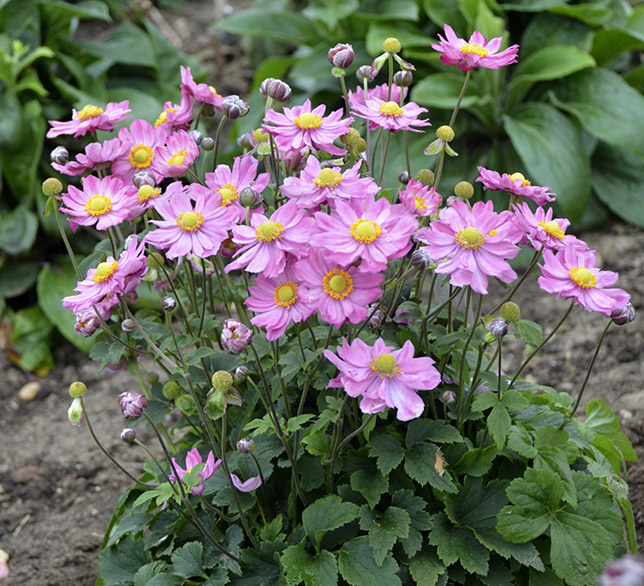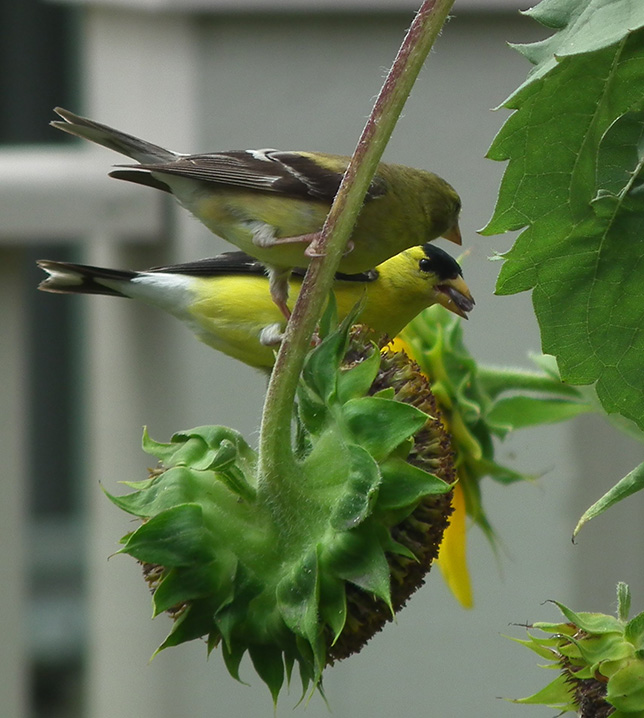The best known fall flower is, of course, the chrysanthemum, or garden mum. Chrysanthemums are hardy perennials, generally returning year to year in zones 5-9. The fall mums available by the thousands in garden centers earlier and earlier each year are by and large no different. So why do people seem to need to plant hardy mums every year?

Fall Mums: What to Know Before You Plant
Will garden mums come back next year?
Well, perhaps. The problem is mainly one of establishment: a plant with a relatively small root system compared to the top growth that is planted in full bloom and often very late in the growing season is not always successful in the long-term. It's basically a recipe for failure, as the poor plant just doesn't have time to prepare itself for a future. Fall mums are grown for temporary impact, not longevity. Additionally, soil that is too wet in winter can cause garden mums to fail, as they need good drainage year-round.
Personally, though, I've never planted a fall mum in my zone 7 garden that didn't come back in spring, whether I wanted it to or not. And why wouldn't I want it to return? Well, not all fall mums are created equal. That decorative orb, so pretty and perfect in its little pot on the garden center bench this fall may not remain a neat, burgundy ball of bloom when its blossoms open in the garden next summer. Yes, summer, unless you keep it pruned to 6 inches tall until about July 4. And even if you do that, it may grow as a ring rather than round. Often the center of the plant will die out, necessitating digging, dividing, and replanting the outside section. And it may also be taller and irregularly shaped. But yes, it lives.
On the other hand, I have planted fall mums more recently that with the appropriate pruning looked almost the same as when I bought them, just larger. It's possible that as breeders have focused on creating garden mums with ever more compact and tidy habits to facilitate retail sales that those growth habits actually persist beyond the annual halloween display. But it's no guarantee.
One thing that's been lost in that quest for tidiness and perfection is the variation in flower shapes that made garden mums more visually appealing and interesting. It's very rare these days to find anything other than the traditional "decorative" flower, although a few daisy-flowered mums pop up here and there. I miss the large, showy, 2-3" or even 4-inch blooms, the spoon-tips, and the quilled mums that were regularly offered years ago. They can still be found at specialty nurseries online, though, and their unique floral display makes them worthy of a place in your fall garden. You may see these offerered as Dendranthema or Chrysanthemum.
Another issue with with the "perfect" garden mum is that nature isn't perfect and these can look stiff and artificial, not blending well with less structured garden styles. They look best in more formal borders or set on the stoop in a basket or attractive cover pot. Be sure that any cover pot drains well, as mums do not like wet feet.
Speaking of pots, trying to combine these sturdy spheres with other plants in a pot is all but impossible, as their rigid shape simply pushes their container mates into in all kinds of unnatural and unattractive positions. At the nursery, we always saved the broken mums for mixed planters since the flat sides allowed other plants to cozy up to them much more nicely.
Florist Mums and Pot Mums: Are They Perennial?
You may also find blooming mums sold at other times of the year, usually near Easter and Thanksgiving. These are usually "florist," or "pot" mums that are hardy only as far north as zone 7 or 8 that are forced into bloom for holiday sales. Large, round-blossomed "football" types and Pelee mums are just two examples.
The problem would be figuring out how hardy the mum actually is, as it likely won't be labeled as anything but "mum" or "chrysanthemum," and even if you know the exact cultivar there's very little, if any, information as to the hardiness for them. Often they haven't even been tested for hardiness, since they're not bred or grown to be anything other than a temporary, decorative, throwaway plant. They're selected for a big floral display and ease of cultivation for the producer.
Focusing on those showy flowers and being greenhouse grown makes the plant less vigorous overall. Think of a pampered household pet attempting to survive in the wilderness -- they're just not prepared for that. "Hardy" mums face the same challenge, but it's even more difficult for florist mums. They usually have a minimal root system and a modicum of foliage, which doesn't supply them with what they need long-term.
Easter season pot mums can be planted after the last frost in spring, to give them the best chance to establish. Assuming you're lucky and they come back, they may not bloom for another season, as forcing tends to disrupt the cycle. If you really wanted to attempt saving a Thanksgiving season florist mum, keep it relatively dry and in a sunny window, letting it rest for the winter, and plant it outside in spring after frost. Either could be kept in a container and brought outside only for the growing season as you would a houseplant. Beyond that, treat both as for garden mums.
How long do garden mums bloom?
Garden mums are generally effective for 4 to 6 weeks, from the point of barely tipping color to browning out. At the latter end of that period you will want to deadhead the faded flowers to keep them as attractive as possible. FYI, when your mum flowers turn brown the plants are not dead, the blooms are just fading, which is completely normal. If your mum foliage turns brown or stems are dying back that's a different story, and they've likely been either left too dry or overwatered.
Fall mums sold in bloom in August will NOT be blooming at Halloween, so if you buy mums early you may need to replace them if you still want flowers later in the season. Mums are best purchased when buds show color and not tightly budded without color -- it's quite possible for that plant tagged "yellow" to bloom purple as there are multiple points along the way where it could be mislabeled. So if color is important to you, wait until you can see it. In warmer areas, prolonged periods of night temperatures over 80 degrees can cause initiated buds to abort or be delayed in flowering, another reason buying tightly budded fall mums may not be advisable.
If you need them in full bloom for an event that's perhaps a week away, purchase with roughly 1/2 to 2/3 of the flowers open. The timeline speeds up considerably with hot weather. Most growers ship at the "cracking color" stage, with buds just showing color, and plants typically reach 50% bloom within 7 to 10 days, depending on variety and climate.
If for some reason you need a certain number of one particular variety of fall mum, you'd be advised to buy them all at the same time. Mum varieties have different blooming periods, from very early to very late, with mid-season types being in 30 to 50% flower by the start of the last week of September on average. So the yellow (or red, orange, etc.) mums you see at the garden center in August will not be the same variety you find in September - the varieties rotate according to their bloom season.
Mums can also be forced to bloom earlier (those August mums) by "blackclothing" -- growers will literally pull a black cloth over the crop to manipulate the day length, mimicking the shorter days that are required to initiate bloom. If you have mums in your garden, be aware that they can be affected by after dark lighting - from streelights, your windows, porch lights, even landscaping lighting. If you have an area that is usually lit up at night you may want to avoid planting your mums there.
And just in case you're wondering, yellow and orange make up roughly 50% of fall mum sales nationwide, followed by red, purple, pink, and white.

Below: 'Pumpkin Pie Orange' garden mum makes a spectacular display massed in a bed with ornamental kale.

Below: The ideal mum, from the breeder and grower perspective. Perfectly round, compact, and covered with buds. They also breed for more flexible stems to avoid shipping damage. Truthfully, they'd like you to accept them a lot smaller, so more can be packed onto a shipping cart!

Below: Often available at retailers for holiday sales, florist mums and pot mums are less cold-hardy than typical garden mums. Most often they are treated as an annual and thrown away when blooming is finished. Here, 'Cosmo Bronze' Pot Mum, photo courtesy Ball Horticulture, www.ballhort.com.




Fall Mums: Low Profit, High Volume
From a grower's standpoint, fall mums are a truly underappreciated plant. They have a long crop time (plugs are planted usually in June), are heavy feeders, often require the application of growth regulators, have a relatively short window to ship, and are generally sold for about one half (or less) of the price of a similarly sized annual or perennial. All this adds up to an expensive crop, but growers that don't offer fall mums have a more difficult time selling other, more profitable plants to retail garden centers during the autumn season.
In decades past you could find "field mums," plants typically grown on a farm, in the ground, that were freshly dug for sales -- sometimes they were "dig yourself," akin to cutting your own Christmas tree, and they certainly didn't look like the perfect plant customers have come to expect. Those days are pretty much gone, at least in my area. Over the years, many smaller growers have also ceased growing containerized fall mums as it just became too costly, and production was only profitable for high volume growers.
So although the fall mum is somewhat ubiquitous, it still gives tremendous bang for your gardening buck. Big, splashy, colorful, and maybe even hardy -- but worth it just for the fantastic fall flower show, even if they can't make it back for a return run.
How to Care for Garden Mums
- Planting
- Timing: Best planted in spring to allow roots to establish, but widely sold and planted in late summer–early fall. Fall-planted mums may not overwinter as reliably.
- Soil: Well-draining, fertile soil enriched with compost or organic matter. Avoid heavy clay or soggy sites; good winter drainage essential.
- Spacing: 18–24 inches apart for good air circulation and full growth.
- Siting (Location & Light)
- Light Needs: Full sun (at least 6 hours daily) promotes dense growth and abundant blooms. A bit of shade from hot afternoon sun may protect flowers from browing early in hot climates. Too much shade causes weak stems and fewer flowers.
- Shelter: Choose a spot protected from harsh winds; avoid low areas where water collects.
- Watering
- Regular Needs: Keep soil evenly moist but never waterlogged.
- Best Practice: Water at the soil line to avoid wetting foliage, which reduces risk of foliar disease and bud rot. Forceful overhead watering may damage branches.
- During Bloom: Consistent moisture is key for long-lasting flowers.
- Fertilizing
- Spring & Summer: Apply a balanced, slow-release fertilizer (10-10-10 or similar). Feed every 4–6 weeks during active growth.
- After Bud Set: Stop fertilizing once flower buds form—too much nitrogen at this stage reduces bloom quality.
- Soil Boost: Incorporate compost in spring for steady nutrients.
- Pruning
Start pruning in spring when plants are 6–8 inches tall, pinching off 1–2 inches of new growth from each stem to encourage branching.
Repeat every 3-4 weeks until mid-July. This creates a bushier plant with more flower buds.
Avoid Late Pruning: Do not prune after mid-July; this can delay blooming
Post-Bloom: Leave stems standing over winter for insulation. Cut back to 2-3 inches in early spring when new growth emerges.
- Overwintering
Hardiness: Most are hardy in USDA Zones 5–9, depending on variety.
Fall-Planted Mums: Treat as annuals if planted late; survival depends on root establishment before frost.
Winter Protection: After a hard frost, mulch plants with 3–4 inches of straw, shredded leaves, or evergreen boughs. Do not cut stems back until spring.
- Pests & Disease
Common Pests: Aphids, spider mites, leaf miners, and thrips. A strong spray of water or insecticidal soap can help.
Diseases: Powdery mildew, botrytis blight, leaf spot, and root rot if overwatered. Improve air circulation and avoid overhead watering to minimize issues.
Preventive Care: Clean up any damaged foliage on the plant and on the ground and dispose of in the trash (do not compost) to reduce overwintering pests and spreading disease spores with splashing water.
- Use in the Garden and Landscape
Borders & Beds: Excellent for late-season color in perennial borders and mixed flowerbeds. Combine with asters, sedum, ornamental grasses, late-blooming salvias, pansies & violas, and ornamental kale.
- Mass Plantings: Striking when grouped in drifts or blocks for bold color.
- Cottage Gardens and Naturalized Plantings: Look for less "perfect" (and to my eye, more attractive) varieties of garden mums, for example 'Mammoth' mums, and other 'Mums of Minnesota' developed by the University of Minnesota. These are exceptionally cold-hardy and include spoon-tipped, quilled, and double decorative flower forms up to 4 inches wide, with various habits from cushion mums growing 12-18 inches to upright growers over 18 inches to shrub cushion mums ('Mammoth') reaching a height of 20-36 inches.
- Cut Flowers: Hardy mums make excellent long-lasting cut flowers--the upright varieties of Minnesota Mums are particularly suited.
- Fall Mums for Container Gardens
- Best Uses: Mums are ideal for porches, patios, and entryways where their dome-shaped habit adds instant seasonal appeal.
- Mums grown in 4.5 or 6 inch pots are perfect for window hayracks or windowboxes and smaller planters.
Container Size: Use a pot 2 inches wider than the mum's current container for best results, larger for mixed plantings.
Easy Refreshing: If you are starting a mixed container with fall mums early in the season, plant it pot and all (without removing from the original pot), so that you can easily exchange for a fresh plant later in the season.
Companions: Pair fall mums with ornamental kale, pansies, violas, grasses, small pumpkins, or gourds for seasonal displays.
Care: Water daily or as needed—containers dry quickly in fall breezes. Do not fertilize mums in bloom.
End of Season: Plants can be composted, or if hardy and planted early enough, transferred into the garden for overwintering.
Note: Our plant recommendations are only suggestions, and may not be appropriate for your particular area. Always consult your local cooperative extension service, master gardener's program, or state natural resources department for information on what plants may be invasive in your location. Thank you!










